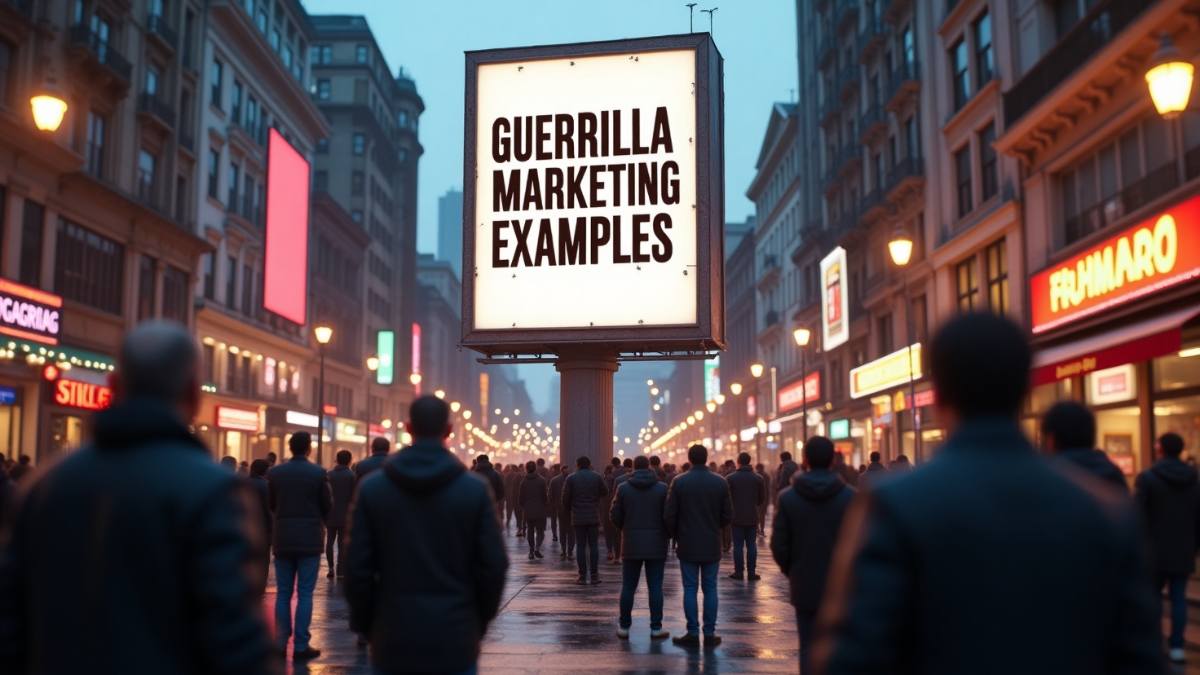In a world stuffed with ads, it’s often the weird stuff that grabs attention. That’s why even now in 2025, guerrilla marketing still does what fancy expensive campaigns often can’t: actually get people to care. When a brand makes you stop and look twice while walking down the street or scrolling your phone, that’s guerrilla marketing doing its thing. Let’s dive into the types, Guerrilla Marketing examples, and how to make your own campaign.
Table of Contents
Why This Matters for Brands and Small Businesses
Ad costs keep going up while people’s attention keeps shrinking. Guerrilla marketing lets brands, especially little guys, compete with the big boys. It’s not about who’s got the most money – it’s about who’s got the most creative ideas.
What does “Guerrilla” Mean?
Where the Term Comes From
“Guerrilla” originally meant small fighter groups who used surprise attacks against bigger armies. It’s scrappy, unexpected, and breaks all the rules.
How Fighting Tactics Became Marketing Tactics
Marketers stole this idea to create campaigns that ignore normal “rules” and instead use creativity, shock, and cleverness to “ambush” people’s attention. No need for big budgets—just smart thinking.
What is Guerrilla Marketing?
Guerrilla marketing means promoting your stuff in public places or online using surprise, creativity, and not much money.
Main Features
- Surprise: It catches people when they’re not expecting it.
- Creativity: It’s about smart ideas, not fat wallets.
- Cheap: You don’t need much cash.
- Memorable: Done right, people can’t forget it—and might share it everywhere.
How It’s Different from Regular Marketing
While regular marketing might spend $7 million on a Super Bowl commercial, guerrilla marketing might hijack a trending topic for $700.
Main Types of Guerrilla Marketing Tactics
1. Street Marketing
Street marketing involves creating attention-grabbing, interactive experiences in public spaces to engage passersby. It aims to disrupt normal routines with unexpected, often playful displays that spark curiosity and make a lasting impression.
- Uses busy locations like sidewalks or parks
- Focuses on creativity and surprise
- Often includes interactive elements
2. Ambient Marketing
Ambient marketing integrates ads seamlessly into everyday surroundings, making the brand feel like a natural part of the environment. The goal is to surprise and delight people with creative, subtle advertising that doesn’t feel intrusive.
- Blends with natural surroundings
- Aims for subtle yet memorable impact
- Uses unusual locations or items for advertisements
3. Ambush Marketing
Ambush marketing occurs when a brand capitalizes on a major event without official sponsorship, creating buzz and gaining exposure. It’s a strategic attempt to associate with high-profile events indirectly.
- Takes advantage of major events
- Avoids paying for official sponsorships
- Generates buzz through clever positioning
Also Read: 20 Digital Marketing Examples to Learn From
4. Guerrilla Projections
Guerrilla projections involve projecting large-scale images or messages onto buildings or other public spaces to create an unexpected, impactful visual. This tactic usually aims for high visibility in urban settings, especially at night.
- Uses large-scale projections for visibility
- Targets high-traffic areas
- Often done at night for maximum effect
5. Experiential Marketing
Experiential marketing focuses on creating immersive, hands-on experiences that allow consumers to interact directly with a brand. The goal is to build a deep emotional connection and memorable experiences.
- Offers direct, physical engagement with the brand
- Creates immersive, multi-sensory experiences
- Aims for an emotional connection with consumers
6. Viral Marketing
Viral marketing involves creating content that is so engaging or entertaining that it spreads quickly through social sharing. The goal is for the content to go viral and reach a large audience organically.
- Designed for easy social sharing
- Leverages humor, emotion, or surprise
- Relies on organic growth and word of mouth
Also Read: 11 Great Product Marketing Examples
8 Most Powerful Guerrilla Marketing Examples
1. IT Movie: Red Balloons Street Art
For the “IT” movie, marketers didn’t use logos or loud ads. Instead, they tied single red balloons to sewer grates around towns. No explanation, just pure creepiness. If you know Pennywise, you’d get it instantly. Locals took photos, shared them on social media, and curiosity did the rest. It was eerie, simple, and honestly, brilliant.
2. Kit Kat: Broken Benches
Kit Kat got super clever with public benches. They made them look like they were snapped right in the middle, just like breaking a Kit Kat bar. It fit perfectly with their “Have a Break” slogan. People loved the playful idea, took tons of photos sitting on the “broken” benches, and shared them everywhere. It made the brand feel fun and memorable.
3. KFC x Crocs: Chicken-Scented Shoes
Yep, this actually happened. KFC and Crocs teamed up to create fried chicken-scented shoes that looked like KFC buckets. They even launched them at New York Fashion Week! It was totally weird, super funny, and exactly the kind of thing the internet loves. The crazy idea went viral fast, showing how being bold and a little bizarre can grab attention.
4. Deadpool’s Tinder Profile
For “Deadpool 2,” the marketing team had a hilarious idea: they made a real Tinder profile for Deadpool himself. Full of his usual sarcastic humor, of course. Fans stumbled across it while swiping, and it didn’t take long before screenshots started flooding social media. It was unexpected, funny, and completely on brand for the character.
5. UNICEF: Dirty Water Vending Machines
UNICEF wanted to make people in New York City think about the global water crisis—and they nailed it. They set up vending machines selling “dirty water” bottles, each linked to different deadly diseases. It was shocking to see, and it forced people to confront an issue they usually don’t think about. The campaign sparked a lot of real conversations.
Also Read: Green Marketing Examples: 15 Inspiring Brands
6. Frontline: Giant Flea Floor Sticker in Shopping Malls
Frontline, a pet care brand, placed a massive floor sticker in the center of busy shopping malls. From above, the sticker showed a dog scratching itself, surrounded by tiny fleas. But the “fleas” were actually people walking across the sticker, seen from the upper floors. This clever illusion caught shoppers’ attention and made the problem of pet pests unforgettable.
7. The Blair Witch Project: Missing Person Posters and Online Hoax
To promote “The Blair Witch Project,” the filmmakers put up missing person posters for the actors and created fake police reports and a website claiming the actors were genuinely missing. This campaign blurred the line between fiction and reality, generating intense curiosity and viral word-of-mouth, making the low-budget film a massive hit.
8. UNICEF Sweden: “Likes Don’t Save Lives” Social Experiment
UNICEF Sweden launched a campaign showing a boy in need, with a message: “Likes don’t save lives. Money does.” They placed posters and ran videos highlighting how social media engagement alone doesn’t help real-world problems. The campaign sparked debate and media coverage, leading to increased donations and awareness about the importance of real action.
How to Plan and Execute a Guerrilla Marketing Campaign
1. Understand Your Audience and Pick the Right Location
You need to know where your audience actually hangs out—both physically and digitally.
Pro Tip: Think about their daily routines. Can you sneak into it?
2. Brainstorm a Creative Idea and Choose a Technique
Not every technique fits every campaign. Street art might work for a youthful brand. An ambient elevator ad might suit a corporate campaign better.
Checklist:
- Does it surprise?
- Is it shareable?
- Is it cost-effective?
- Does it align with brand values?
3. Execute Strategically
- Timing matters. Hit them when least expected.
- Permissions: Sometimes you’ll need city permits; sometimes you take the risk.
- Backup Plan: What if security shuts you down?
4. Measure Your Campaign Results
Track social mentions, foot traffic spikes, QR code scans, website visits, and press coverage.
Key Metrics:
- Engagement (likes, shares, comments)
- Press mentions
- Word-of-mouth buzz
- Sales lifts (if applicable)
Also Read: 30 Content Writing Examples to Inspire You
Pros and Cons of Guerrilla Marketing
Advantages:
1. Budget-Friendly:
Most guerrilla campaigns don’t need fat stacks – just big ideas. Small-time hustlers can make serious noise without dropping major cash by just using their brain instead of their wallet. Even broke-ass startups can look bigger than they are with one smart stunt that gets people talking.
2. Highly Memorable:
Regular ads fade from memory like yesterday’s lunch, but weird guerrilla stuff sticks with you. People forget billboards but remember that time a brand did something crazy on their street corner. Your brain holds onto surprising stuff – it’s just how we’re wired. Normal marketing gets tuned out, but the unexpected shit actually registers.
3. Viral Potential:
Do something wild enough and watch people share it everywhere without you spending another dime. One good stunt can blow up across Facebook, TikTok, and Instagram faster than you can say “marketing budget.” People love sharing weird, funny, shocking stuff – they basically do your advertising for free when they hit that share button.
4. Builds Emotional Connections:
Regular ads just sell stuff, but guerrilla marketing hits you in the feels. Whether it’s making people laugh their ass off or dropping their jaw in surprise, these emotional gut-punches make people actually give a damn about your brand. When someone feels something strong, they remember who made them feel it.
Challenges:
1. Risk of Backlash if Misunderstood:
One wrong move and your clever idea becomes a PR nightmare. People get offended by anything these days, and social media can turn your marketing fail into a trending hashtag within hours. What seemed funny in the planning room might piss off half your potential customers in real life.
2. Potential Legal Issues:
That awesome street art campaign might get you slapped with vandalism charges if you didn’t get permits. Cops don’t care about your marketing goals when you’re breaking city ordinances. Many guerrilla marketers have ended up with fines or cease-and-desist letters because they didn’t do their homework on local laws.
3. Hard to Predict Outcomes:
Unlike paying for exactly 100,000 ad impressions, guerrilla stuff is a total crapshoot. Your stunt might go mega-viral or it might totally flop with nobody giving a damn. You can’t guarantee results like with boring traditional ads – it’s basically rolling the dice and hoping people care about your weird marketing scheme.

Also Read: Live Advanced Digital Marketing Course
Conclusion
Cheap marketing beats expensive ads. In a world full of boring commercials, weird and different stuff still gets noticed. Whether you’re huge or tiny, thinking outside the box helps you compete.
Agreed, guerrilla stuff can be risky, like maybe breaking rules or not knowing what’ll happen, but the payoffs can be huge: going viral, making people care, and getting fans.
Bottom line, it’s not about being the loudest—it’s about making people remember you. If you’ve got guts, guerrilla marketing might be your best bet.
FAQs: Guerrilla Marketing Examples
1. Why do small businesses like guerrilla marketing?
Small businesses don’t have fat marketing budgets. Guerrilla marketing wins because it needs smart thinking, not deep pockets. A single clever stunt can create massive buzz without breaking the bank. It levels the playing field when you can’t afford traditional advertising.
2. How much does guerrilla marketing cost?
It can be cheap as dirt or a bit pricier – totally depends on what you’re planning. Some campaigns just need basic supplies and creativity. Flashier stuff like projections or pop-ups will cost you more. But compared to traditional advertising? Usually way more affordable.
3. Can guerrilla marketing mess up? What should brands watch out for?
Absolutely, it can blow up in your face if audiences misinterpret it or get irritated. Smart brands double-check their message and make sure they’re not crossing legal lines. The essential question before launching: “Is this going to tick people off?” Better to ask now than apologize later.
4. What’s different between guerrilla marketing and regular marketing?
Regular marketing plays it straight – you buy ad space on TV, in newspapers, or online. Guerrilla marketing plays it sneaky. It ambushes people in real life or online with something unexpected, interesting, or bold that burrows into their memory.
5. How do you make guerrilla stuff go viral?
You can’t guarantee viral status, but you improve your odds by creating something funny, emotional, or genuinely surprising. When people immediately want to share it with friends, you’ve struck gold. Keep it uncomplicated and highly shareable.
6. Is guerrilla marketing legal? Any rules?
Generally legal if you use common sense. But when you’re setting up stuff in public spaces, like installations or events, you might need permits. Breaking rules can lead to hefty fines, so do your homework before executing your brilliant plan.

